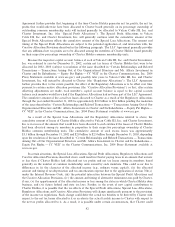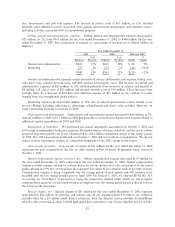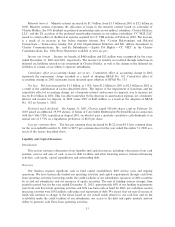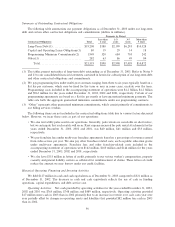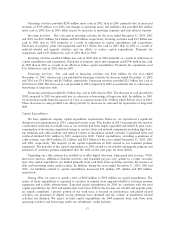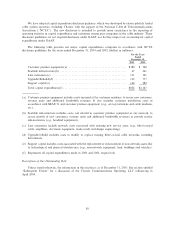Charter 2003 Annual Report Download - page 52
Download and view the complete annual report
Please find page 52 of the 2003 Charter annual report below. You can navigate through the pages in the report by either clicking on the pages listed below, or by using the keyword search tool below to find specific information within the annual report.increase in the average number of customers resulted in approximately 7% of the increase in video revenue,
whereas approximately 93% resulted from the increase in average price of our video products.
Revenues from high-speed data services provided to our non-commercial customers increased $189 mil-
lion, or 128%, from $148 million for the year ended December 31, 2001 to $337 million for the year ended
December 31, 2002. Approximately 73% of the increase related to the increase in the average number of
customers, whereas approximately 27% related to the increase in average price of the service. The increase was
primarily due to the addition of 585,200 high-speed data customers. Between 2001 and 2002, we were able to
oÅer this service to more of our customers, as the estimated percentage of homes passed that could receive
high-speed data service increased from 66% to 82% as a result of our ongoing system upgrades.
Advertising sales revenues consist primarily of revenues from commercial advertising customers,
programmers and other vendors. Advertising sales increased $105 million, or 53%, from $197 million in 2001
to $302 million in 2002. The increase was due to an increase of $53 million, from $13 million in 2001 to
$66 million in 2002, in advertising contracts with programmers, $40 million of additional sales primarily due to
the increased advertising capacity as a result of an increased number of channels carried by our systems and
$14 million related to the acquisition of AT&T Broadband systems in June 2001. For the years ended
December 31, 2002 and 2001, we received $13 million and $14 million, respectively, in advertising revenues
from our two largest suppliers of digital set-top terminals representing 0.3% and 0.4% of total revenues,
respectively. Revenues from advertising provided to vendors and programmers are recognized based upon the
fair value of advertising. Vendor advertising purchases are made pursuant to written agreements that are
generally consistent with other third-party commercial advertising agreements and at prices that we believe
approximate fair value. In some cases we purchased equipment from the vendors at the same time.
Commercial revenues consist primarily of revenues from video and high-speed data services to our
commercial customers. Commercial revenues increased $38 million, or 31%, from $123 million for the year
ended December 31, 2001, to $161 million for the year ended December 31, 2002, primarily due to an increase
in commercial high-speed data revenues.
Other revenues consist of revenues from franchise fees, equipment rental, customer installations, home
shopping, dial-up Internet service, late payment fees, wire maintenance fees and other miscellaneous revenues.
For the years ended December 31, 2002 and 2001, franchise fees represented approximately 46% and 39%,
respectively, of total other revenues. Other revenues decreased $22 million, or 6%, from $368 million for the
year ended December 31, 2001 to $346 million for the year ended December 31, 2002. The decrease was due
to decreases in late payment fees charged to customers and other miscellaneous revenues. Franchise fee
revenues are collected from customers and remitted to franchise authorities.
The decrease in accounts receivable of 11% compared to the increase in revenues of 20% is primarily due
to the timing of collection of receivables from programmers for fees associated with the launching of their
networks, coupled with our tightened credit and collections policy. These fees from programmers are not
recorded as revenue but, rather, are recorded as reductions of programming expense on a straight-line basis
over the term of the contract. Programmer receivables decreased $27 million, or 28%, from $97 million as of
December 31, 2001 to $70 million as of December 31, 2002.
50




